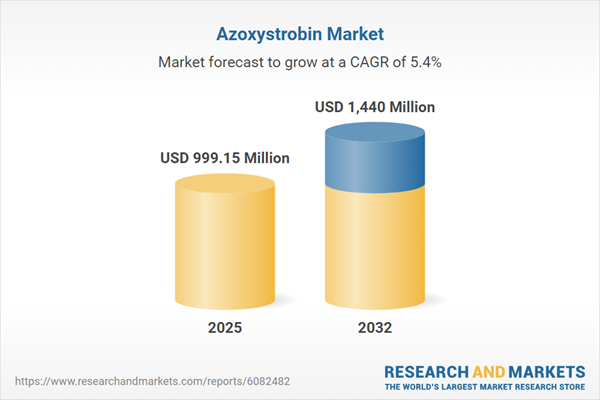Speak directly to the analyst to clarify any post sales queries you may have.
The global azoxystrobin market is undergoing dynamic transformation, shaped by regulatory policies, sustainability imperatives, and advances in digital agriculture. Senior executives in agrochemicals and crop protection must closely monitor these shifts to inform resilient business strategies and capitalize on evolving growth opportunities.
Market Snapshot: Azoxystrobin Market Size and Growth Overview
The azoxystrobin market size increased from USD 947.91 million in 2024 to USD 999.15 million in 2025, with a projected CAGR of 5.44%. By 2032, the market is expected to achieve USD 1.44 billion, reflecting robust demand across diverse cropping systems and widespread adoption fueled by regulatory, environmental, and technological drivers.
Scope & Segmentation of the Azoxystrobin Market
This research offers comprehensive coverage across multiple dimensions, delivering a detailed analysis relevant to executive decision-making:
- Crop Types: Cereals (barley, maize, rice, wheat), fruits and vegetables (apples, grapes, potatoes, tomatoes), oilseeds and pulses (canola, chickpea, lentil, soybean), ornamentals (flowers, nurseries, turf)
- Formulation Formats: Oil dispersion, suspension concentrate, water dispersible granule, wettable powder
- Application Methods: Foliar application, seed treatment, soil treatment
- Sales Channels: Direct sales, distributors, e-commerce platforms, retailers
- End User Groups: Commercial growers, independent farmers
- Regional Analysis: Americas (United States, Canada, Mexico, Brazil, Argentina, Chile, Colombia, Peru), Europe, Middle East & Africa (UK, Germany, France, Russia, Italy, Spain, Netherlands, Sweden, Poland, Switzerland, United Arab Emirates, Saudi Arabia, Qatar, Turkey, Israel, South Africa, Nigeria, Egypt, Kenya), and Asia-Pacific (China, India, Japan, Australia, South Korea, Indonesia, Thailand, Malaysia, Singapore, Taiwan)
- Company Landscape: Syngenta International AG, Bayer CropScience AG, BASF SE, FMC Corporation, Corteva Agriscience, ADAMA Ltd., Nufarm Limited, UPL Limited, Sumitomo Chemical Co., Ltd., Shandong Rainbow Chemical Co., Ltd.
Technology Adoption and Regional Relevance
Segments integrate next-generation technologies, including AI-driven disease prediction, sensor-based residue monitoring, and drone-based application systems, ensuring azoxystrobin reaches both large-scale operations and specialized local markets. Each region demonstrates distinct adoption factors based on climate volatility, infrastructure, compliance requirements, and crop mix, reinforcing the importance of tailored approaches for successful implementation.
Key Takeaways for Senior Decision Makers
- Azoxystrobin’s broad-spectrum efficacy, operational flexibility, and stewardship frameworks have made it integral to modern integrated pest management programs.
- Targeted formulation and application technologies support sustained effectiveness while helping growers manage resistance risks and environmental requirements.
- Collaboration across industry, research, and regulatory bodies fosters innovation and continuous improvements in agronomic performance and market access.
- Regional factors, such as regulatory thresholds and crop-specific disease pressures, necessitate bespoke strategies for optimal yield and compliance.
- Market dynamics are further influenced by the rise of digital agronomy, data-driven application timing, and specialized e-commerce distribution models.
Tariff Impact: Navigating 2025 Trade Policy Shifts
The imposition of United States tariffs on azoxystrobin imports in 2025 introduced additional cost layers and prompted market-wide adjustments. Stakeholders responded by revising supply agreements, strengthening local manufacturing options, and streamlining customs processes. These actions have reinforced the importance of supply chain diversification and strategic scenario planning, ensuring price stability and operational continuity.
Methodology & Data Sources
Report findings are based on a blended methodology utilizing exhaustive secondary research—including peer-reviewed publications, regulatory dossiers, and industry bulletins—and primary research conducted with agronomists, distributors, formulators, and growers across global regions. Rigorous validation was achieved through expert peer review and triangulation of quantitative and qualitative insights.
Why This Report Matters for Strategic Leadership
- Enables senior leadership to anticipate and respond to emerging supply chain and regulatory risks.
- Supports informed product portfolio decisions aligned with regional market trends and sustainability targets.
- Provides actionable intelligence for optimizing distribution, stewardship, and manufacturing investments in volatile policy environments.
Conclusion
The azoxystrobin market’s trajectory highlights the intersection of regulatory evolution, digital innovation, and the drive for sustainable agricultural outcomes. This report empowers decision-makers to adapt, innovate, and maintain market leadership amid ongoing sector transformation.
Table of Contents
3. Executive Summary
4. Market Overview
7. Cumulative Impact of Artificial Intelligence 2025
Companies Mentioned
The companies profiled in this Azoxystrobin market report include:- Syngenta International AG
- Bayer CropScience AG
- BASF SE
- FMC Corporation
- Corteva Agriscience
- ADAMA Ltd.
- Nufarm Limited
- UPL Limited
- Sumitomo Chemical Co., Ltd.
- Shandong Rainbow Chemical Co., Ltd.
Table Information
| Report Attribute | Details |
|---|---|
| No. of Pages | 189 |
| Published | October 2025 |
| Forecast Period | 2025 - 2032 |
| Estimated Market Value ( USD | $ 999.15 Million |
| Forecasted Market Value ( USD | $ 1440 Million |
| Compound Annual Growth Rate | 5.4% |
| Regions Covered | Global |
| No. of Companies Mentioned | 11 |









